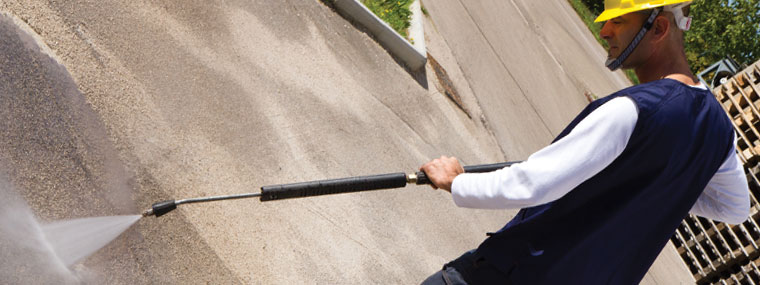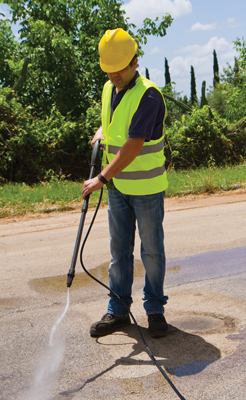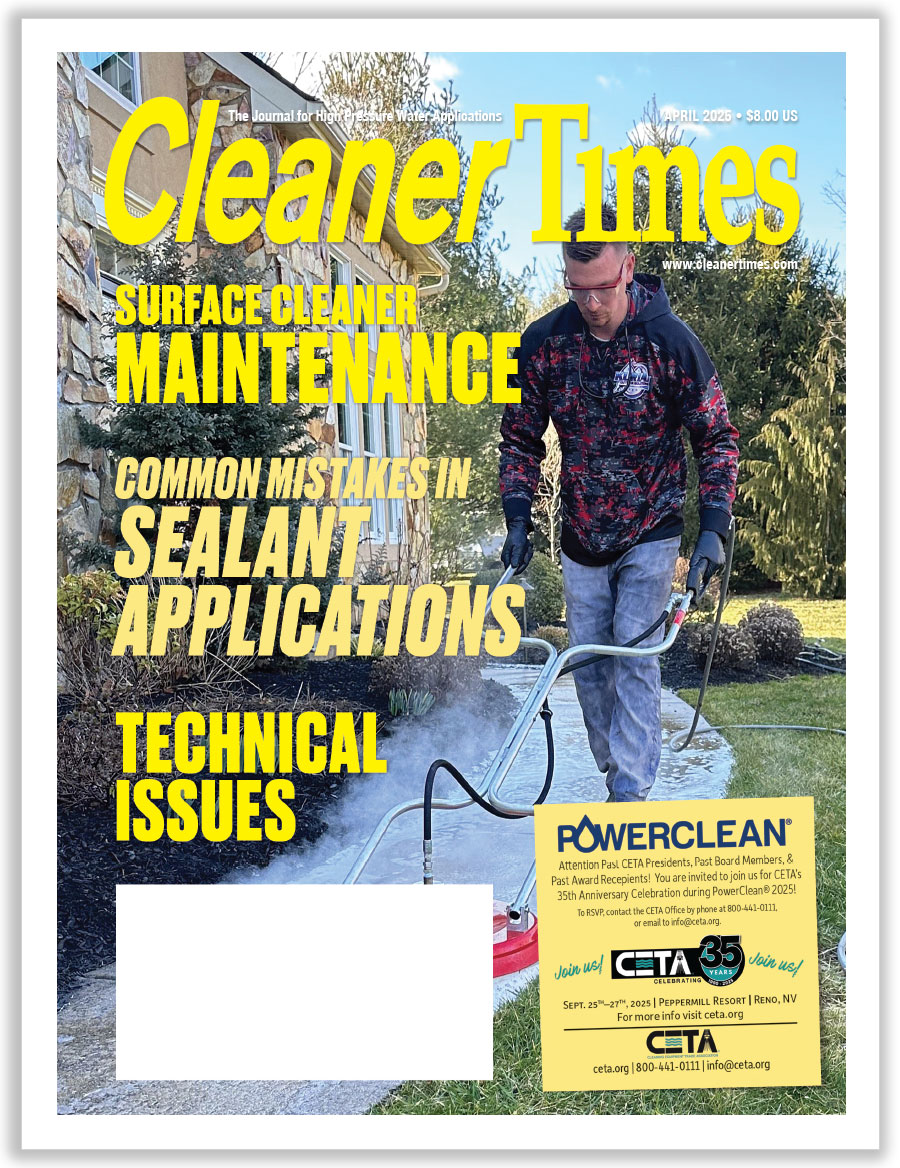
Cleaning Brick and Concrete
By Diane M. Calabrese / Published February 2022

Editor’s Note: This article is discussing cleaning of brick and concrete. It does not explore in detail about cleaning brick in new construction like the two-part series by Terri Perrin that appeared in the January issue at www.cleanertimes.com. The second part of Terri’s article can be found in this issue on page 18.
Passions rarely ignite when the discussion is how best to clean a particular surface. That is, unless the surface is brick or concrete.
Preservationists fret a lot about brick—especially painted brick (which we will bypass). Concrete, not so much, but maintaining the integrity of concrete so that it is less vulnerable to freezing and thawing—and subsequently cracking or simply crumbling—is an imperative.
Contract cleaners who tackle brick and concrete in landmark and historic buildings can expect significant guidance from the owner of the structure. Similarly, buildings belonging to the federal government are enveloped by strict advice from the General Services Administration (GSA), to which we turn in the next section.
The residential property owner generally takes a utilitarian view of brick and concrete. He or she wants to maintain it so that it keeps its integrity and looks good. Used correctly, sealing and coating enhance the outcome of cleaning.
Yet contract cleaners working on residential properties may consider them so routine that they miss something. Even the most oft-completed project requires attention to detail.
“Often the things that are missed are specific to the job,” says Mark Tuliano with Deco Products Inc. in Denver, CO. “Sometimes it can be efflorescence, other times it may be rust or other organic material that needs a more efficient cleaning prior to the sealing process.”
How can a contractor be certain to identify critical issues? “Not all jobs are the same; you must look at each one individually,” says Tuliano.
Tuliano speaks from a background with 40 years of paver installation and sealing experience. He often contributes his expertise to courses for contractors.
Skipping just one step in a process can yield poor outcomes, and Tuliano gives an example. “Pavers need
sanding; it’s critical preparation to assist in proper sealing,” says Tuliano. And he adds it’s not just the responsibility of the contractor to do the job correctly, which it is.
But the customer has a responsibility, too. That is to be adequately informed. “Customers should always ask, ‘What does the sealing process entail?’” says Tuliano. “This way they understand the expectations being set by the applicator.”
More information applies to the frontside, the backside, and the middle of a project. The better the understanding among all parties, the less likely a passionate discussion will ensue.
Good To Know
Brick and concrete get lumped together (with stone) in the category masonry. Masonry is a nod to the masons that assembled the structures (or once did—3D printers that pour concrete add a new facet).
A free and expansive primer on cleaning masonry is available from GSA at https://www.gsa.gov/technical-procedures/general-cleaning-exterior-brick-masonry. We highlight some of the basic information in the paragraphs that follow in this section.
Less is more when cleaning masonry. Yes, it’s true for most substrates because using the minimum of pressure, water, and chemical reduces cost and environmental concerns, but it’s particularly true for masonry.
 Intact and residential masonry not of an historic sort can tolerate pressure in the 500 to 1000 psi range, but aged masonry requires tender loving care, and that includes a low pressure of 100 to 400 psi with generous flow. A 40-degree nozzle is safest, although a 15-degree nozzle can be used as needed.
Intact and residential masonry not of an historic sort can tolerate pressure in the 500 to 1000 psi range, but aged masonry requires tender loving care, and that includes a low pressure of 100 to 400 psi with generous flow. A 40-degree nozzle is safest, although a 15-degree nozzle can be used as needed.
Care must be taken not to put an angle on the spray. (The nozzle should be perpendicular to the surface.) A cone of water should hit the surface in the most even pattern possible.
The rinse is critical when cleaning masonry. Residue from chemicals can contribute to staining. (Back to staining below.)
GSA does not shun hot water (up to 160ºF) and sees it as a useful choice when coupled with alkaline cleaners. (No to using hot water with acidic cleaners.) The hot water provides a big assist when the goal is to remove paint, grease, or oil.
Before commencing a brick masonry cleaning job, a contractor must assess the condition of the brick and mortar. There are many handy charts for doing this, and the GSA reprints one of them from a popular handyperson journal.
Essentials for evaluating the brick masonry and mortar are these: If the bricks look as though they are disintegrating, they are. If bricks show flakes or chips (spalling), remedial methods must take priority over, or with, cleaning. If it takes (not recommended) several heavy blows with a hammer and a chisel to breach the brick, the brick is in good condition.
Old vs. New Brick
Contractors tackling projects involving historic buildings will receive specific guidelines for cleaning or submit methods for approval. Contractors cleaning brick on new construction get the best results and lower the possibility of damage by knowing the type of brick and finding the manufacturer’s instructions on how to clean it.
Much work for contractors can be had in cleaning new brick construction. Aligning with a builder who needs a cleaning partner to tidy up bits of mortar on brick, etc., following the work of masons can be a profitable arrangement.
If working with a builder, a contractor will be assured of knowing the type of brick and how to clean it. (There are hundreds of types of bricks.) If a contractor is cleaning for a building owner, he or she will be responsible for identifying the type of bricks and getting the instructions for cleaning from the manufacturer.
Issues that arise when cleaning old bricks are largely the same as those that arise when cleaning new bricks. They begin with efflorescence.
Efflorescence is not a welcome sight when it covers brick. Although some look on the powdery or dusty white clusters as picturesque, building owners worry about what it indicates, and it generally does indicate trouble, such as moisture behind the brick.
Many things cause moisture to permeate bricks, including ill-fitted flashing on the roof and blocked weep holes in the brick. A contractor must be certain to clarify the existence of efflorescence before a project commences so that the building owner will not attribute it to the method used in cleaning.
Rinsing with low pressure and good flow is necessary to ensure removal of any chemicals used in cleaning masonry. Not only efflorescence but also vanadium staining, acid burn, rust stains, and metallic oxidation stains can result if chemical residue remains.
Vanadium (element 23, V) charms when the element gives a green hue to certain emeralds, and it toughens up the toughest tools, but as a noticeable residue on bricks, it is unappreciated. When vanadium salts dissolve in water, some may eventually come out of solution. On a brick they appear as a putrid green-yellow stain.
Vanadium stains are harmless, but no one admires them on brick. Many proprietary products on the market are designed to remove them.
Concrete
Contractors who clean concrete driveways know that all concrete is not the same. Newer concrete generally has a lower coal ash content, and the concrete is much more likely to degrade to bits of rubble.
Rotary surface cleaners are a good match for new or old concrete that is not cracked or flawed. They also offer a fast approach to cleaning a large area.
When contractors clean structural concrete, they serve as a back-up line of defense—backing up building inspectors. Any cracks in foundational structures such as piles or support columns should be reported to the owner and a record of the report maintained.
Concrete in parking garages, on pedestrian walkways, and in mass transit entrances take a lot of abuse. Chewing gum, confectionary stains (from candy), beverage stains, grease stains, tobacco stains, and mildew stains are just a few of the 32 stains on concrete for which the GSA (GSA.gov) provides recommendations for removal.
One reason to keep concrete clean is to ensure a pleasant environment. A more important reason is to ensure no crack or flaw is obscured.
Organic solvents should not be used to clean concrete unless necessary. Use mild or strong soap in lieu of any chemicals whenever possible.
Just as contractors focusing on brick cleaning can align with builders, contractors focusing on concrete cleaning may find it profitable to align with restoration companies. When a basement floods, or when a sewer backs up, the after-the-triage cleanup will entail washing the concrete floor and cinderblock walls of the basement.
Contractors who tackle work in basements know that the number one priority is to ensure there are no live utilities. Electric power should be shut off outside the house by the electric company. Gas should also be shut off by the gas company. The rule is to never rely on interior shutoffs.
Battery-powered equipment—pressure washer and/or surface cleaner—makes it possible to work safely in basements when power shut-off protocols to the structure have been fulfilled.
A good way to increase and build a repertoire in cleaning brick and concrete is to assess possibilities in the region served. Then pursue them via contact with private or municipal owners directly or by contacting the companies (e.g., builders, restoration) with which a subcontract might be possible.





